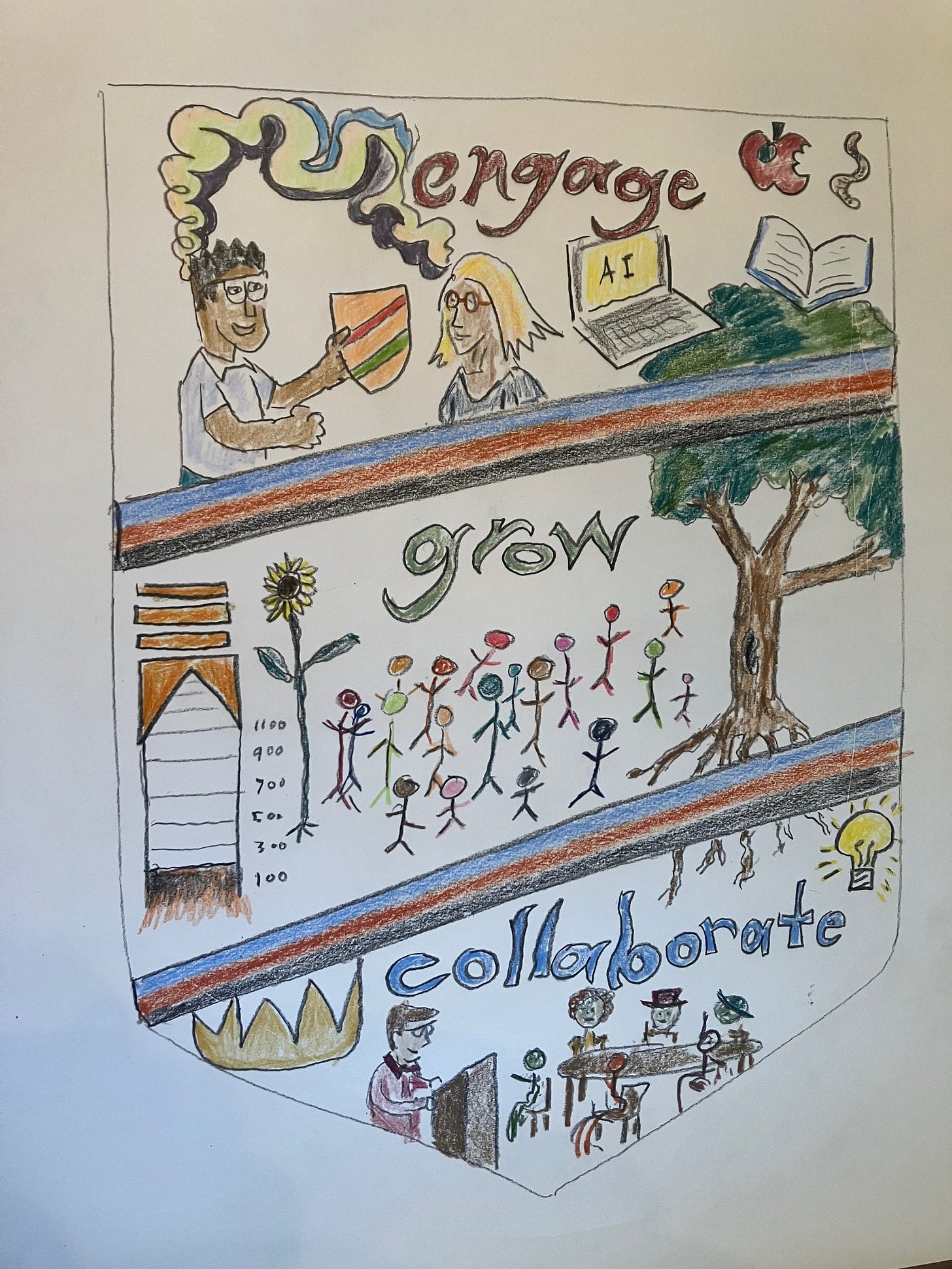The Purpose of Education
In my recent guest post on AI Supremacy, I outlined several Purposes and Recommendations for AI-Responsive Education. In this post, I am taking a closer look at the Principle of Purpose and my Recommendation to involves students in the vital work of Redefining the Purpose of Education in the wake of the global pandemic and since the rise of generative AI.
Knowing that my writing and posts tends to be more theoretical, I will focus today’s efforts on developing a lesson plan that other practitioners can use and adapt in various settings in order to help realize this principle and recommendation in tangible ways.
First let’s briefly take a look at the Principle and Recommendation in question.
PURPOSE: Students and teachers need to define common and creative purposes to ground engagement with human-machine networks and to realize those purposes through meaningful action.
Student Involvement: Involve students in the process of redefining the purpose of education in light of generative AI technologies. Provide programs guiding students through a multi-year journey of discovering and defining their creative purpose, allowing discussions about AI usage to align with these contexts.
Inspiration 1: Ken Montgomery
I most recently heard an educator use the term “creative purpose” in Michael B. Horn’s podcast focused on Next-Gen High Schools. In this podcast, Ken Montgomery, one of the co-founders of Design Tech, places a strong emphasis on shaping the curriculum around the concept of "creative purpose." At Design Tech, this work is collaborative, multi-disciplinary, multi-year, and constantly evolves in light of a series of challenging enrichment experiences that include community service, travel, and internships. What impresses me most about Design Tech’s approach is how it builds onto the previous decade’s educational revolution in personalization and individualization of instruction and evaluation. At Design Tech, students not only engage with a curriculum tailored to their unique interests and requirements, but they also infuse it with a creative purpose that wide and grand as the world itself.
Inspiration 2: Ross Wehner
A second source of inspiration for my work on “creative purpose” is Ross Wehner’s TED Talk, “What If the Purpose of School Were Purpose?” In this captivating presentation, Wehner endeavors to redirect our schools' attention from specific content objectives to a more comprehensive approach centered on nurturing purpose-driven individuals. These individuals are profoundly connected to the world around them and are actively developing the skills and competencies necessary to expand and intensify their engagement. Here, the order of things is most significant. Purpose comes first and allows students to recognize and identify the skills that are necessary to realize a particular pathway and outcome.
Wehner’s talk could not be anymore relevant to this particular moment when new technologies are rapidly outmoding existing skill-sets, competencies, and literacies. Wehner’s approach opens up two productive responses to student inquiries about the utility of particular foci within instructional settings. First, a purpose-driven orientation allows students to have almost laser-focus on the precise skills they will need to become who they aspire to be. Second, a purpose-driven orientation at the same time also offers the instructor space to continue to work with potentially outmoded processes to the extent that they can be rationalized as a part of unfolding the student’s grander purpose.
Inspiration 3: Rhetorical Theory
A final source of inspiration for my lesson on “creative purpose” is my work as a rhetorical theorist. Purpose is an extremely useful concept when it comes to making sense of complex works of media. It combines the unifying aspect of “form” with the creative process of “intentionality” and “connectivity,” resulting in a highly interactive network or field wherein a hierarchy of sub-purposes can be braided kaleidoscopically to generate myriad, complex effects and experiences. Notably, too, purposes do not unfold in a vacuum but intersect with the purposes of other media, agents, institutions, and historical forces.
In the context of my own work, I conceive of purpose as less an individualistic enterprise, and more of a collaborative effort where one’s purpose is constantly tested, refined, revised, and extended through interaction with the purposes of others. The sooner our students learn this important lesson, the better—and with enough forethought and skill, we can successfully model this interactivity in the classroom and across the curriculum.
Lesson Framwork:
The following lesson is designed for an 9th grade English class, but can be easily adapted for other grade levels and disciplines.
I am nestling it into a unit on Wes Moore’s The Other Wes Moore and a conversation about how different contexts/purposes play out in the lives of the main characters.
This lesson will be the first in a series of purpose-driven exercises that my students will work through this school year.
The overarching goal of these assignments is to help students articulate their personal objectives. Subsequently, we can embark on a series of exercises centered around the broader purpose of my course, their utilization of LLMs within my class, and their contributions to high school life in a more general sense. As we scale-up these conversations and the attending purposes, I will draw in more of the 9th-grade team of instructors to see how these conversations might help shape instruction, activites, assessments, and policies moving forward with this particular group of young persons. Fortunately, I teach at a relatively small school with a faculty that already works very collaboratively, so such a grassroots effort is feasible. Adapting these methods for other school settings will be a serious challenge, but know that students will appreciate even the slightest gesture in this direction: A moment to pause a set the agenda of their lives for themselves.
Redefining Our Purpose Too!
Remember that we teachers can also engage in our own purpose-orientation work. When I graduated from my doctoral program, I worked through Richard Bolles’s What Color Is Your Parachute? The program therein is challenging, thorough, and aesthetically pleasing. By the end of the process, you will have created a beautiful flower schematic that highlights your competencies, passions, values, and purposes, allowing you to discern possible openings and new pathways in your professional, social, and personal life. For me, the work had a delayed impact. It took several months of processing, along with continued experiments in personal and professional pathways, for me to realize that I indeed wanted to return to K-12 instruction after a long period in Higher Ed. I think students can sense when their instructors are also engaged in the work continuous the work of purpose-orientation—as opposed to just assigning it in class. I’d recommend that teachers create a Purpose Shield alongside their students in the spirit of Collaboration that undergirds the Principle of Purpose.
Figure 1. “Achilles’ Shield in Homer’s Iliad. Study.com
Defining Your Creative Purpose: Part 1
Purpose Shield
In section 3 of The Other Wes Moore, each character is hard at work defining their “creative purpose” in life.
“Creative purpose” is the larger orientation, intention, mission, objective, values, and/or goals that give meaning, energy, significance, joy, and/or grounding to a time in life, project, plan, collaboration, and/or lifetime. Creative purposes come in many forms.
Creative Purpose: Interdynamics
For some people, a creative purpose is very tangible: a series of explicit goals, such as achieving a particular level of education or finding work in a particular professional field.
But for many other people, creative purpose is something larger and more abstract. It has to do with achieving a particular quality of life such as tranquility, deep engagement, service to others, or open-mindedness or becoming a particular kind of person such as a more confident, generous, patient, or inquisitive person.
In this project, I am going to ask you to start to think about your creative purpose. This will be the first in a series of exercises focusing on your creative purpose, so you don’t have to have all the answers today. Think of this work as a first draft.
____________________________________________________________________________
Today, we are going to create a Purpose Shield.
On the back of the Shield, you will write 3 purpose statements.
A purpose statement will look and sound a lot like one of our Standards.
It will start with AN INFINITIVE: to do, to be, to become, to have, to discover…
It will include sufficient information to describe the purpose
It will define a purpose that is achievable in the FOCUS period or experience.
Your purpose statements will focus on 3 different periods or experiences:
This class, 9th Grade English
What goal do you want to set for this class?
A goal can be academic, social, or personal.
Academic: To push myself to be more engaged in class conversations
Social: To work on speaking with persons outside my friend group
Personal: To tell myself everyday that I am a good reader and writer
This school year, 2023-24
What goal do you want to set for this school year?
A goal can be academic, social, or personal.
Academic: To practice 5-7 math problems every evening
Social: To cultivate a friendship I have neglected since 6th grade
Personal: To get to bed before 10:30 every school day
While in high school, 2023-27
What goal do you want to set for yourself over the next 4 years?
A goal can be academic, social, or personal.
Academic: To develop a competitive art portfolio and apply to 3 art school
Social: To maintain a group of friends outside of MVS
Personal: To develop a sense of self confidence not rooted in my grades
____________________________________________________________________________
Figure 2. Purpose Shield Example (Blank)
On the front of the Shield, I want you to do the following:
Condense each purpose statement down to 1-4 words, and creatively write each word on the shield in its own separate section.
Ex. ENGAGED IN CONVERSATION; CULTIVATE FRIENDSHIP; ART PORTFOLIO
Pick a color scheme that is symbolic of who you are. Think about what each color means. These colors should predominate in your artwork on the front of the shield, but feel free to use other colors when drawing your scenes, images, and symbols.
Ex. Red = Engagement; Black = Friendship; Blue = Creativity
For each condensed Purpose Statement, draw an image, scene, or symbol that expresses the feeling, power, energy, or deeper meaning of that purpose statement.
Finally, feel free to add a quote from a favorite author, musician, poet, entertainer that helps to encapsulate your overall creative purpose for the next 4 years. Here, you can drift a little from your explicit purpose statements. Please write down the name of the source underneath the quotation.
Figure 3. Purpose Shield Example (Author’s Completed).
Putting Purpose Statement to Work: Conferences
After students develop these initial purposes, I plan on incorporating them into my conference cycles. Prior to conferences, students will be required to gather evidence of progress that they will then deploy as part of their conference conversation. In my conferences, I will ask my students to walk guardians and teachers through their goals and purposes, and then to speak to tangible ways they have worked toward their realization.
In this way, students will take greater ownership over a process in which they usually disempowered and under the evaluative gaze of the “other.” I had the good fortune to work at a vibrant Montessori Middle School for several years over a decade ago, and we found that empowering students through self-led conferences lifted the entire school community into a higher state of engagement, purpose-orientation, grace and civility, and curiosity and inquiry. Once again, these practices are difficult to adapt to larger school environments, but if we are to truly center schools around student’s purposes, we just might have to take such radical steps.
Thanks for reading Educating AI.
Nick Potkalitsky Ph.D








